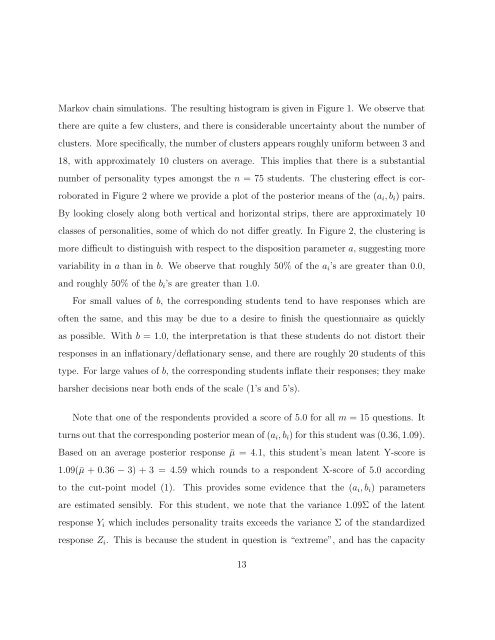Bayesian analysis of ordinal survey data using the Dirichlet process ...
Bayesian analysis of ordinal survey data using the Dirichlet process ...
Bayesian analysis of ordinal survey data using the Dirichlet process ...
You also want an ePaper? Increase the reach of your titles
YUMPU automatically turns print PDFs into web optimized ePapers that Google loves.
Markov chain simulations. The resulting histogram is given in Figure 1. We observe that<strong>the</strong>re are quite a few clusters, and <strong>the</strong>re is considerable uncertainty about <strong>the</strong> number <strong>of</strong>clusters. More specifically, <strong>the</strong> number <strong>of</strong> clusters appears roughly uniform between 3 and18, with approximately 10 clusters on average. This implies that <strong>the</strong>re is a substantialnumber <strong>of</strong> personality types amongst <strong>the</strong> n = 75 students. The clustering effect is corroboratedin Figure 2 where we provide a plot <strong>of</strong> <strong>the</strong> posterior means <strong>of</strong> <strong>the</strong> (a i , b i ) pairs.By looking closely along both vertical and horizontal strips, <strong>the</strong>re are approximately 10classes <strong>of</strong> personalities, some <strong>of</strong> which do not differ greatly. In Figure 2, <strong>the</strong> clustering ismore difficult to distinguish with respect to <strong>the</strong> disposition parameter a, suggesting morevariability in a than in b. We observe that roughly 50% <strong>of</strong> <strong>the</strong> a i ’s are greater than 0.0,and roughly 50% <strong>of</strong> <strong>the</strong> b i ’s are greater than 1.0.For small values <strong>of</strong> b, <strong>the</strong> corresponding students tend to have responses which are<strong>of</strong>ten <strong>the</strong> same, and this may be due to a desire to finish <strong>the</strong> questionnaire as quicklyas possible. With b = 1.0, <strong>the</strong> interpretation is that <strong>the</strong>se students do not distort <strong>the</strong>irresponses in an inflationary/deflationary sense, and <strong>the</strong>re are roughly 20 students <strong>of</strong> thistype. For large values <strong>of</strong> b, <strong>the</strong> corresponding students inflate <strong>the</strong>ir responses; <strong>the</strong>y makeharsher decisions near both ends <strong>of</strong> <strong>the</strong> scale (1’s and 5’s).Note that one <strong>of</strong> <strong>the</strong> respondents provided a score <strong>of</strong> 5.0 for all m = 15 questions. Itturns out that <strong>the</strong> corresponding posterior mean <strong>of</strong> (a i , b i ) for this student was (0.36, 1.09).Based on an average posterior response ¯µ = 4.1, this student’s mean latent Y-score is1.09(¯µ + 0.36 − 3) + 3 = 4.59 which rounds to a respondent X-score <strong>of</strong> 5.0 accordingto <strong>the</strong> cut-point model (1). This provides some evidence that <strong>the</strong> (a i , b i ) parametersare estimated sensibly. For this student, we note that <strong>the</strong> variance 1.09Σ <strong>of</strong> <strong>the</strong> latentresponse Y i which includes personality traits exceeds <strong>the</strong> variance Σ <strong>of</strong> <strong>the</strong> standardizedresponse Z i . This is because <strong>the</strong> student in question is “extreme”, and has <strong>the</strong> capacity13
















